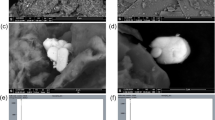Abstract
A microelectrophoresis technique was used to study the electrochemical properties of apatite, quartz and hornblende from Chilembwe phosphate ore;and apatite, calcite and magnetite from Kaluwe phosphate ore. The tests were conducted in distilled water and the water near the source of the phosphate ores under study.
The apatite from Chilembwe gave an isoelectric point (i.e.p.) value of pH 6 in distilled water while in Mankwala Dam water the i.e.p. was of pH 4. Quartz and hornblende were negatively charged throughout the entire pH range studied in both cases. Apatite from Kaluwe showed an i.e.p. value of pH 3.8 while calcite and magnetite had i.e.p. values of pH 6.1 and 4.1 in distilled water, respectively. However, in Kaluwe water the i.e.p. of calcite shifted to pH 8.8 resulting in a charge reversal on either side of the i.e.p. There was no marked difference in the i.e.p. values of apatite and magnetite in Kaluwe water from those in distilled water. Comparison of zeta potential-curves for different apatites showed that they exhibit different i.e.p. values because of their variable composition.
Similar content being viewed by others
References
Deer WA, Howie RA and Zussman J (1982) An introduction to Rock Forming Minerals. Essex, England: Longman Group Limited
International Fertilizer Development Center (IFDC) (1987) Charicterization of an ore sample from Chilembwe deposit, Zambia. Internal report
Japan International Cooperation Agency (JICA) (1984) A prefeasibility study for the phosphate development project. The Republic of Zambia. Final report.
Lombe WC (1983) The surface chemistry and flotation of spodumene, lepidolite and associated silicates in the presence of dodecylamine. Ph.D thesis, Imperial College, London
Mishra SK (1978) The electrokinetics of apatite and calcite in inorganic electrolyte environment. Inter Jour Min Proc 5: 69–83
Mujogyatwok G (1983) Phosphate (apatite)-rich bodies of Chilembwe in Sinda West PL 183. Geol of Zambia Newsletter No 23
Smith AL (1973) Electrical phenomena associated with the solid/liquid interface in dispersion of powders in liquids. London: Applied Science Publishers
Somasundaran P (1968) Zeta potential of apatites in aqueous solutions and its charge during equilibriurn. J Colloid Interface Sci 27: 659–666
Somasundaran P and Agar GE (1972) Further streaming potential study of apatite in inorganic electrolyte. Trans SME/AIME 252: 348–350
Turner DC, Anderson LS, Punukollu SN, Sliwa A and Tembo F (1990) Igneous phosphate resources in Zambia. In:Notholt,AJG Sheldon,RP and Davidson, D (eds) Phosphate deposits of the world 2: pp 247–257. Cambridge University Press
Van Kauwenbergh SJ (1991) Overview of phosphate deposits in East and Southeast Africa. Fertilizer Research 30: 127–150
Van Wazer JR (1958) Phosphorus and its Compounds. New York: Chemistry Interscience
Wippo RE and Murowchick B (1967) The crystal chemistry of some sedimentary apatites. Trans AIME 238: 257–268
Author information
Authors and Affiliations
Rights and permissions
About this article
Cite this article
Simukanga, S., Lombe, W.C. Electrochemical properties of apatite and other minerals of Zambian phosphate ores in aqueous solution. Fertilizer Research 41, 159–166 (1995). https://doi.org/10.1007/BF00750758
Received:
Accepted:
Issue Date:
DOI: https://doi.org/10.1007/BF00750758




